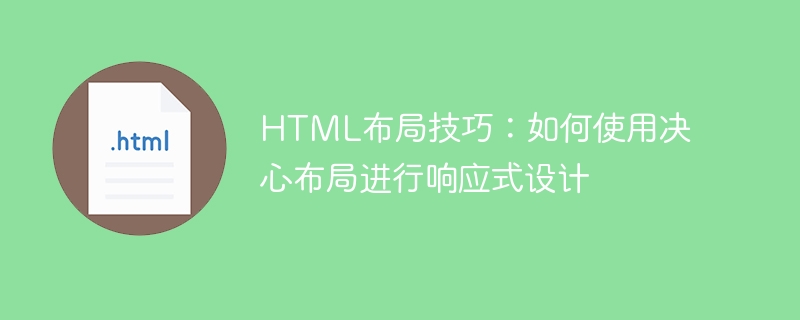Home >Web Front-end >HTML Tutorial >HTML Layout Tips: How to Use Determination Layout for Responsive Design
HTML Layout Tips: How to Use Determination Layout for Responsive Design
- WBOYWBOYWBOYWBOYWBOYWBOYWBOYWBOYWBOYWBOYWBOYWBOYWBOriginal
- 2023-10-19 11:39:11735browse

HTML Layout Tips: How to use Determination Layout for responsive design, specific code examples required
Introduction:
With the continued popularity of mobile devices and tablets , the responsive design of web pages has become more and more important. When designing and developing web pages, using flexbox layout can help us achieve flexible and responsive layout. This article will introduce the basic principles and usage of determination layout, and provide some practical code examples.
1. What is determination layout?
Determination layout is a new layout model for web page layout, which can easily implement adaptive and responsive design. It is based on the box model and uses containers and items to achieve flexible layout. Determination layout has the following characteristics:
- The items in the container are arranged according to the direction of the main axis and cross axis, and can be laid out horizontally or vertically.
- The size of the project can be scaled as needed to accommodate screens of different sizes.
- Can easily center, align and sort items.
2. How to use determination layout?
- Create a flex container:
In HTML, we can create a flex container by setting the display attribute of the container to flex. For example:
<div class="flex-container"> <!-- 这里是项目(flex items) --> </div>
- Set the properties of the project:
In the determination container, we can set the properties of the project to achieve flexible layout effects. Here are some common item properties:
- flex-grow: Specifies the item's ability to stretch. The value of this property determines the proportion of the remaining space allocated to the item. The default value is 0, which means no stretching.
- flex-shrink: Specifies the shrinkage ability of the item. The value of this property determines how much the item shrinks when space is insufficient. The default value is 1, which means it will shrink.
- flex-basis: Specifies the initial size of the item. The value of this attribute can be a specific pixel value or percentage, or auto can be set as an adaptive size. The default value is auto.
- flex: abbreviation of the above three properties. For example, flex: 1 1 auto; means that the item has equal ability to expand and contract, and the initial size is adaptive.
The following is an example of using determination layout:
<div class="flex-container"> <div class="flex-item">项目1</div> <div class="flex-item">项目2</div> <div class="flex-item">项目3</div> </div>
In CSS, we can use the following styles to define the containers and items of determination layout:
.flex-container {
display: flex;
flex-direction: row; /* 水平布局 */
justify-content: center; /* 水平居中 */
align-items: center; /* 垂直居中 */
}
.flex-item {
flex: 1 1 auto; /* 项目伸展和收缩能力相等,初始大小自适应 */
margin: 10px;
}3. Application examples
The following is a simple example that shows how to use determination layout to implement a responsive navigation bar:
<div class="flex-container"> <a href="#" class="flex-item">首页</a> <a href="#" class="flex-item">产品</a> <a href="#" class="flex-item">关于我们</a> <a href="#" class="flex-item">联系我们</a> </div>
.flex-container {
display: flex;
justify-content: space-between; /* 水平间隔平均分布 */
align-items: center; /* 垂直居中 */
background-color: #f0f0f0;
padding: 10px;
}
.flex-item {
flex: 1 1 auto;
margin: 0 10px;
text-align: center;
}In the above example, the links in the navigation bar will automatically be based on Adapt the layout to the size of the screen and maintain an even distribution of horizontal intervals.
Conclusion:
Flexible responsive design can be easily implemented using Determination Layout, allowing web pages to adapt to different sizes of device screens. By setting the properties of containers and items, we can achieve customized layout effects. I hope that the code examples provided in this article can help you better master the use of determination layout and apply it to your web design in practice.
The above is the detailed content of HTML Layout Tips: How to Use Determination Layout for Responsive Design. For more information, please follow other related articles on the PHP Chinese website!
Related articles
See more- How to use PHP for responsive design development?
- How to use Vue and Element-UI to implement distributed layout and responsive design
- Mobile adaptation and responsive design of real-time chat system based on PHP
- HTML layout tips: How to use positioning layout for element control
- HTML layout tips: How to use the overflow attribute to control image scaling

